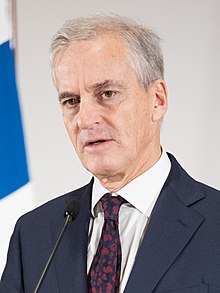| This article needs additional citations for verification. Please help improve this article by adding citations to reliable sources. Unsourced material may be challenged and removed. Find sources: "Prime Minister of Norway" – news · newspapers · books · scholar · JSTOR (January 2025) (Learn how and when to remove this message) |
| Prime Minister of Norway | |
|---|---|
| Norges statsminister (Bokmål) Noregs statsminister (Nynorsk) | |
 State coat of arms of Norway State coat of arms of Norway | |
 Flag of Norway Flag of Norway | |
 Incumbent IncumbentJonas Gahr Støre since 14 October 2021 | |
| Executive branch of the Norwegian Government Office of the Prime Minister | |
| Member of | Council of State |
| Reports to | The Storting |
| Residence | Statsministerboligen |
| Seat | Regjeringskvartalet, Oslo |
| Nominator | The previous prime minister |
| Appointer | Monarch of Norway on the advice of the previous prime minister or the president of the Storting |
| Term length | No fixed term Serves as long as the incumbent does not have the majority of the Storting against them. |
| Constituting instrument | Constitution of Norway |
| Inaugural holder | Peder Anker |
| Formation | 17 May 1814 |
| Deputy | Deputy Prime Minister |
| Salary | annual: 1,735,682 NOK/US$ 168,023 |
| Website | Prime Minister's Office |
The prime minister of Norway (Norwegian: statsminister, which directly translates to "minister of state") is the head of government and chief executive of Norway. The prime minister and Cabinet (consisting of all the most senior government department heads) are collectively accountable for their policies and actions to the monarch, to the Storting (Parliament of Norway), to their political party, and ultimately the electorate. In practice, since it is nearly impossible for a government to stay in office against the will of the Storting, the prime minister is primarily answerable to the Storting. The prime minister is almost always the leader of the majority party in the Storting, or the leader of the senior partner in the governing coalition.
Norway has a constitution, which was adopted on 17 May 1814. The position of prime minister is the result of legislation. Modern prime ministers have few statutory powers, but provided they can command the support of their parliamentary party. Prime ministers control both the legislature and the executive (the cabinet) and hence wield considerable de facto powers. As of 2021 the prime minister of Norway is Jonas Gahr Støre, of the Labour Party, replacing Erna Solberg of Conservative Party, who resigned in October 2021.
Unlike their counterparts in the rest of Europe, Norwegian prime ministers do not have the option of advising the king to dissolve the Storting and call a snap election. The constitution requires that the Storting serve out its full four-year term. If the prime minister loses the Storting's confidence, they must resign.
See also
References
- "Norway's Struggle with Her King" (PDF). The New York Times. 11 November 1882.
External links
| Heads of government of Norway (List) | ||
|---|---|---|
| First ministers, 1814–1873 | ||
| Prime ministers, 1873–1905 | ||
| Prime ministers, 1905–1940 | ||
| WWII, 1940–1945 |
| |
| Prime ministers, 1945– | ||
| Cabinets of Norway | |
|---|---|
| 1814–1884 |
|
| 1884–1945 |
|
| 1940–45 |
|
| 1945–present |
|
| Norway articles | |||||||
|---|---|---|---|---|---|---|---|
| History |  | ||||||
| Geography | |||||||
| Politics | |||||||
| Economy | |||||||
| Society |
| ||||||
| Heads of state and government of Europe | |||||||
|---|---|---|---|---|---|---|---|
| Heads of state |
| ||||||
| Heads of government |
| ||||||
| |||||||
| Prime ministers | |
|---|---|
| Prime ministers by country |
|
| Defunct title | |